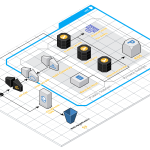As cloud computing continues to evolve, serverless architectures are becoming increasingly popular due to their ability to simplify infrastructure management and improve scalability. However, the shift to serverless computing introduces new security challenges and considerations that organizations must address to ensure the safety and compliance of their cloud environments. In this article, we will explore the future of cloud security in a serverless world and discuss strategies for ensuring safety and compliance.
1. Understanding Serverless Security Challenges
Serverless computing abstracts away infrastructure management and provides a model where developers focus solely on writing and deploying code. While this approach offers numerous benefits, it also introduces unique security challenges that differ from traditional cloud models.
Key Security Challenges:
- Increased Attack Surface: Serverless architectures can lead to an expanded attack surface due to the dynamic nature of functions and their interactions with other services. Each function is a potential target for attackers.
- Data Privacy: Serverless functions often interact with various data sources and services, raising concerns about data privacy and protection. Ensuring that sensitive data is handled securely is crucial.
- Limited Control: In a serverless environment, cloud providers manage the underlying infrastructure, which means organizations have limited control over the security of the runtime environment and underlying hardware.
- Dependency Management: Serverless applications rely on third-party libraries and dependencies, which can introduce vulnerabilities if not properly managed and updated.
2. Enhancing Security in Serverless Architectures
To address the security challenges of serverless computing, organizations must implement robust security practices and strategies tailored to the serverless model.
Key Security Strategies:
- Function Isolation: Design serverless functions to be as isolated as possible. Each function should perform a specific task and have minimal access to other functions and resources. This limits the impact of potential security breaches.
- Least Privilege Access: Apply the principle of least privilege to serverless functions. Ensure that each function has only the permissions it needs to perform its tasks and no more. Use fine-grained access controls to manage permissions effectively.
- Secure Code Practices: Follow secure coding practices to mitigate vulnerabilities. Regularly review and update code, perform static and dynamic analysis, and implement secure coding guidelines to prevent common security issues.
- Dependency Management: Keep third-party libraries and dependencies up to date to address known vulnerabilities. Use automated tools to monitor and manage dependencies, and implement processes for reviewing and validating external code.
3. Leveraging Cloud Provider Security Features
Cloud providers offer a range of security features and tools that can help organizations secure their serverless environments. Understanding and utilizing these features is essential for maintaining a secure serverless architecture.
Cloud Provider Security Features:
- Built-In Security Controls: Take advantage of built-in security controls provided by cloud platforms, such as encryption, access management, and network security features. Ensure that these controls are properly configured and enabled.
- Monitoring and Logging: Use cloud provider monitoring and logging services to track the activity of serverless functions and detect potential security incidents. Implement centralized logging to aggregate and analyze security-related data.
- Threat Detection and Response: Leverage threat detection and response tools offered by cloud providers to identify and respond to security threats in real-time. These tools can help detect anomalies and potential attacks in serverless environments.
- Security Compliance Services: Utilize compliance and security services offered by cloud providers to support regulatory requirements. These services can assist with audits, assessments, and compliance reporting.
4. Ensuring Compliance in a Serverless Environment
Compliance with industry regulations and standards is a critical aspect of cloud security. Organizations must ensure that their serverless architectures meet regulatory requirements and maintain data protection standards.
Compliance Considerations:
- Data Protection Regulations: Adhere to data protection regulations such as GDPR, CCPA, and HIPAA. Implement measures to ensure that sensitive data is handled securely, including encryption, data masking, and access controls.
- Audit and Reporting: Establish processes for auditing serverless functions and maintaining compliance documentation. Regularly review and update compliance reports to reflect changes in the environment and regulatory requirements.
- Third-Party Assessments: Engage with third-party security and compliance assessors to evaluate the security posture of your serverless architecture. External assessments can provide valuable insights and identify areas for improvement.
- Incident Response Planning: Develop and test an incident response plan specifically for serverless environments. Ensure that your response plan includes procedures for handling security incidents and breaches in a serverless context.
5. Best Practices for Serverless Security
Implementing best practices can help organizations strengthen the security of their serverless environments and reduce the risk of security incidents.
Security Best Practices:
- Secure API Endpoints: Protect API endpoints that trigger serverless functions using authentication, authorization, and input validation. Ensure that only authorized users can access and interact with the functions.
- Encrypt Data: Use encryption to protect data both in transit and at rest. Ensure that sensitive data is encrypted before being stored or processed by serverless functions.
- Regular Security Assessments: Conduct regular security assessments, including penetration testing and vulnerability scanning, to identify and address potential security issues in your serverless architecture.
- Educate and Train: Provide security training and education for developers and operational teams. Ensure that they are aware of serverless security best practices and understand their role in maintaining a secure environment.
6. The Future of Serverless Security
As serverless computing continues to evolve, we can expect advancements in security technologies and practices that address emerging threats and challenges.
Future Trends:
- Enhanced Security Tools: Advances in security tools and technologies will provide more comprehensive protection for serverless environments. Expect improvements in automated threat detection, vulnerability management, and incident response capabilities.
- Integration with AI and Machine Learning: The integration of artificial intelligence (AI) and machine learning (ML) will enhance threat detection and response in serverless environments. AI-driven security solutions can analyze vast amounts of data to identify patterns and anomalies.
- Regulatory Evolution: As regulations and standards evolve, serverless security practices will need to adapt to new requirements. Organizations should stay informed about changes in regulatory landscapes and ensure that their security practices remain compliant.
Conclusion
The shift to serverless computing offers numerous benefits, including improved scalability, reduced operational overhead, and enhanced development agility. However, it also presents unique security challenges that organizations must address to ensure the safety and compliance of their cloud environments.
By implementing robust security practices, leveraging cloud provider security features, and adhering to compliance requirements, organizations can effectively manage the security of their serverless architectures. As the technology continues to evolve, staying informed about emerging trends and advancements will be crucial for maintaining a secure and compliant serverless environment.
Embracing serverless computing with a strong focus on security and compliance will enable organizations to fully realize the potential of this transformative technology while safeguarding their data and applications in the cloud.
To learn more about our vision stay up to date with latest news and trends and how we’re making a difference, We invite you to OC-B by Oort X Media.




